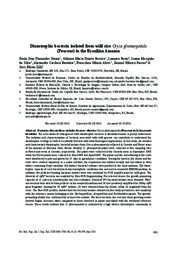Diazotrophic bacteria isolated from wild rice Oryza glumaepatula (Poaceae) in the Brazilian Amazon.
Diazotrophic bacteria isolated from wild rice Oryza glumaepatula (Poaceae) in the Brazilian Amazon.
Resumo: The association of wild grasses with diazotrophic bacteria in Brazilian biomes is poorly understood. The isolation and characterization of bacteria associated with wild grasses can contribute to understand the diazotrophic ecology as well as to identify bacteria with biotechnological applications. In this study, we isolated and characterized diazotrophic bacterial isolates from Oryza glumaepatula collected in Cerrado and Forest areas of the Amazon in Roraima State, Brazil. Healthy O. glumepatula plants were collected at five sampling sites at Forest and seven at Cerrado, respectively. The plants were collected at the Cerrado areas in September 2008 while the Forest plants were collected in June/2008 and April/2009. The plants and the soil adhering to the roots were transferred to pots and grown for 35 days in greenhouse conditions. During the harvest, the shoots and the roots were crushed separately in a saline solution; the suspension was diluted serially and inoculated in Petri dishes containing Dyg?s medium. All distinct bacterial colonies were purified in the same medium. The diazotrophic capacity of each bacterium in microaerophilic conditions was assessed in semisolid BMGM medium. In addition, the pellicles forming bacterial isolates were also evaluated by PCR amplification for nifH gene. The diversity of nifH+ bacteria was analyzed by Box-PCR fingerprinting. For selected strains, the growth promoting capacity of O. sativa as a model plant was also evaluated. A total of 992 bacterial isolates were obtained. Fiftyone bacteria were able to form pellicles in the semisolid medium and 38 also positively amplified the 360bp nifH gene fragment. Among the 38 nifH+ isolates, 24 were obtained from the shoots, while 14 originated from the roots. The Box-PCR profiles showed that the bacterial isolates obtained in this study presented a low similarity with the reference strains belonging to the Herbaspirillum, Azospirillum and Burkholderia genus. The growthpromoting ability was confirmed for at least five isolates. For these bacteria, the root and shoot growing results showed higher increases when compared to those observed in plants inoculated with the evaluated reference strains. These results indicate that O. glumaepatula is colonized by a high diverse diazotrophic community in the Brazilian Amazon. Further investigations are now being carried out to determine the taxonomic positions of these isolates and their growth promoting mechanisms.
Ano de publicação: 2013
Tipo de publicação: Artigo de periódico
Unidade: Embrapa Semiárido
Palavras-chave: Arroz, Bactérias, Doença, Ecologia microbiana, Fixação biológica de nitrogênio, Plantas, rice
Observações
1 - Por padrão são exibidas publicações dos últimos 20 anos. Para encontrar publicações mais antigas, configure o filtro ano de publicação, colocando o ano a partir do qual você deseja encontrar publicações. O filtro está na coluna da esquerda na busca acima.
2 - Para ler algumas publicações da Embrapa (apenas as que estão em formato ePub), é necessário ter, no celular ou computador, um desses softwares gratuitos. Sistemas Android: Google Play Livros; IOS: iBooks; Windows e Linux: software Calibre.
Acesse outras publicações
Acesse a Base de Dados da Pesquisa Agropecuária (BDPA) para consultar o acervo completo das bibliotecas da Embrapa.

